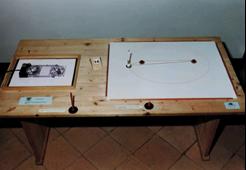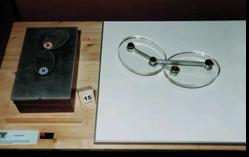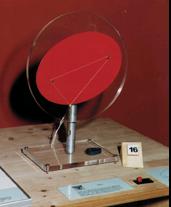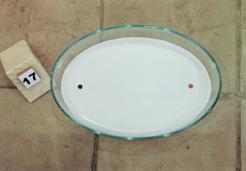- Straight lines and circles
- Conic sections
- Other curves
|
|

|
The simplest way to draw an ellipse is with a piece
of string, a bit like with the circumference we drew at
the start.
A circumference has all the points at the
same distance from the centre, so we can draw it with a
string, keeping one end fixed and rotating the other one
with a marker. When the circumference gets longer and
becomes an ellipse, the centre, so to say, divides up
into two points: the foci. These have a characteristic
property: if you take any point on the ellipse and you
unite them with the two foci, the sum of the lengths of
the two segments is always the same.
This property can be used to draw an ellipse on the
ground: fix two stakes on the foci and attach to them the
two ends of a string. If now we bring a pencil around so
that the string is always kept taut, the curve we have
drawn is an ellipse, called the gardener's ellipse,
because this method is often used to draw elliptical
flower beds.
|

|
The same property can be used to build elliptical
gears. If you take to identical ellipses, dispose them so
that each of them can rotate around one of their foci,
and if the distance between the stakes is equal to the
length of the string that describes the ellipse, the two
ellipses always remain tangent, and the rotation of one
drags along the other. Moreover, if the first one rotates
uniformly, the second has a variable velocity, higher the
nearer the tangent point is to the fixed focus. If the
two ellipses are very oblong, while the first rotates in
24 hours, the second takes up almost all the time to go
half around, and goes the other half in a few minutes.
This phenomenon is used for date display mechanisms in
watches.
|

|
Another important property of the ellipse is that the
line perpendicular to the ellipse in any of its points
divides the angle formed by the string (that is, by the
lines that link the point to the foci) in two halves.
This property is relevant to light reflection. When a ray
of light reflects on a mirror, be it flat or curved, the
perpendicular to the mirror makes equal angles with both
the incident ray and with the reflected ray, that is,
with the incoming and the outgoing rays. But then, a ray
of light which starts from a focus behaves like the
string in the gardener's ellipse: after having reflected
on the ellipse, it will strike the other focus.
|

|
The same is true for any type of ray: light, sound,
heat. In every case, all the rays that originate from a
focus, after a reflection on the ellipse, will
concentrate in the other. This is the reason for the name
foci ("fires"): if one places a source
of heat on one of the foci, the heat concentrates in the
other and it can light up a piece of paper or an
inflammable material.
A simple kitchen pan (of an
approximately elliptical shape) with its bottom covered
in water can be used to illustrate the phenomenon. If you
touch the water with a finger on one of the foci (marked
by a dot on the bottom), you create concentric waves
that, after having reflected on the side of the pan,
concentrate on the other focus.
|
|
|